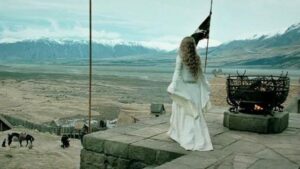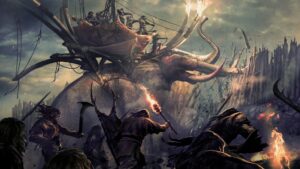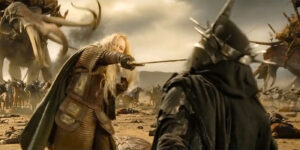Whether he wants to be or not, Peter Jackson is bound to Middle-earth, and no amount of success as a groundbreaking documentary filmmaker will ever put distance between him and the twenty year-old adaptation of J.R.R. Tolkien’s The Lord Of The Rings that, both as a result of his indisputable talent and in spite of his worst impulses as a director, is still rightly regarded as a masterpiece by most and as the only “true” iteration of Tolkien’s world and characters by some. His stay in that world could have ended on a high note, with the thirteen Academy Awards he and his crew earned for The Return Of The King in 2004, but Warner Brothers wasn’t satisfied, even if he was, so they got him back for The Hobbit – robbing us of a Guillermo del Toro-directed two-part adaptation of the slim children’s book that would probably have been much better, and saddling Jackson with a mess that would become his to bear the blame for as it bloated into a trilogy of unfocused and almost unwatchable films.

And yet…he’s back again, his name all over the first trailer for the feature-length anime The War Of The Rohirrim (written by Philippa Boyens, Jackson’s co-writer on both the Rings and Hobbit trilogies), which also incorporates footage from Jackson’s films. And this isn’t a one-off, but the first of many prequels to The Lord Of The Rings that Warner Brothers, under the backwards-looking leadership of David Zaslav, is hoping Jackson will produce and help to promote, if not direct. The Hunt For Gollum, featuring the return of Andy Serkis, is already set for 2026. The cynic in me warns that Zaslav’s end goal here is to remake the original trilogy in ten years time with Jackson at the helm once more, starring a digitally de-aged Elijah Wood and an AI deepfake of the by-then 95 year-old Sir Ian McKellen. But I can take some comfort in the fact that The War Of The Rohirrim, at least, is a stand-alone, and the story it tells is removed from the events of The Lord Of The Rings by hundreds of years, and features only a handful of characters and recognizable locations from the films.
Granted, one of those characters happens to be Éowyn, Shieldmaiden of Rohan – voiced by Miranda Otto, who originated the role in Jackson’s films. Her return is admittedly a big factor in my excitement for The War Of The Rohirrim, so I can’t say I’m entirely immune to Warner Brothers’ blatant nostalgia bait, but actresses are so rarely invited to come back to franchises more than twenty years on (one particularly egregious example of this is Julia Sawalha, 55, being told she was “too old” to reprise the voice-role of Ginger in the recent sequel to Chicken Run) that Otto being the nostalgia bait feels significant.

Éowyn serves as the film’s narrator, helping to ease the audience into the history of Rohan and preface the story of the actual protagonist, a woman named Hera (voiced by Gaia Wise) with a similar disposition to Éowyn herself, who was born prior to the year 2754 of the Third Age (for context, The Hobbit takes place in the year 2941, and The Lord Of The Rings between 3001 and 3021). Hera is a non-canonical name for a canonical character, the daughter of Helm Hammerhand, the ninth King of Rohan (voiced by Succession‘s Brian Cox). Tolkien, whose strengths as a worldbuilder did not include fleshing out female characters, writes of her only that her hand in marriage was sought by Lord Freca on behalf of his son Wulf (voiced by Shadow And Bone‘s Luke Pasqualino). Her name, deeds, and dates of birth and death are nowhere recorded, so War Of The Rohirrim has had to invent these and all other details about her from scratch. In the film, she appears to be Wulf’s childhood friend, but the two are estranged after a duel of words between their fathers escalates into a literal duel that ends with Freca’s death at Helm Hammerhand’s hammer hands.
In the war that follows, an army of Dunlendings led by Wulf and based out of the old fortress of Isengard (not yet occupied by Saruman) are joined by Haradrim sweeping across Gondor, no doubt due to Sauron’s meddling. Helm is forced to retreat to a citadel in the White Mountains that he fortifies, which in later days will be known by the name Helm’s Deep (yes, that Helm’s Deep). There, the Rohirrim make what they believe will be their last stand, all through the Long Winter (also probably attributable to Sauron). No spoilers, but it’s a gripping tale even briefly sketched out in the Appendices to The Return Of The King. And animated? It’s nothing short of stunning.
Director Kenji Kamiyama, whose previous work includes Ghost In The Shell: Stand Alone Complex, Blade Runner: Black Lotus and The Ninth Jedi (one of my favorite episodes of the anime anthology series Star Wars: Visions), brings to War Of The Rohirrim the clean and exceptionally fluid animation style that characterizes his output and befits Middle-earth. It is a far cry from Ralph Bakshi’s 1978 animated adaptation of The Lord Of The Rings, which has acquired a cult-classic status for its janky rotoscoping, but also serves as a great example of why rotoscoping, as an animation technique, isn’t in common use nowadays. War Of The Rohirrim, by contrast, feels like it has the potential to raise the bar exponentially for future animated films set in this world (not that any have been announced, but if War Of The Rohirrim is a success, it won’t be long before other stories in the Appendices get the same treatment). And in a rare show of confidence from a studio that has been pretty risk-averse under its current leadership, Warner Brothers is giving it a coveted December release in theaters, on IMAX screens, where it will be going up against Kraven The Hunter, Sonic The Hedgehog 3, and Mufasa: The Lion King, as well as the previous month’s presumably leggy blockbusters Wicked: Part One, Gladiator 2, and Moana 2.

The big question now is whether audiences will show up for an animated Lord Of The Rings prequel featuring the voice of only one supporting cast member from the original films. The power of Peter Jackson’s name is not as strong as it once was: Mortal Engines, the biggest flop of 2018, was also a Jackson production, albeit unassociated with Middle-earth. And Amazon is hoping to sate nostalgia for Lord Of The Rings with the second season of The Rings Of Power, releasing in just a few days. But there’s no good reason that adaptations can’t coexist, and War Of The Rohirrim draws on a completely different period of Middle-earth’s history than Rings Of Power and visually is more in line with Jackson’s (hugely successful) trilogies. Personally, I haven’t tired yet of seeing these stories brought to life, and I think some competition would be healthy for the franchise, if franchise it has become. We’ll just have to wait and see if general audiences are accepting of the distinction.
Trailer Rating: 8/10





